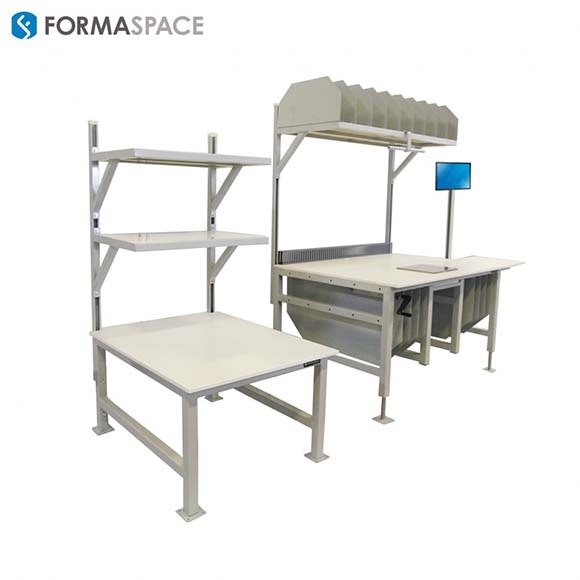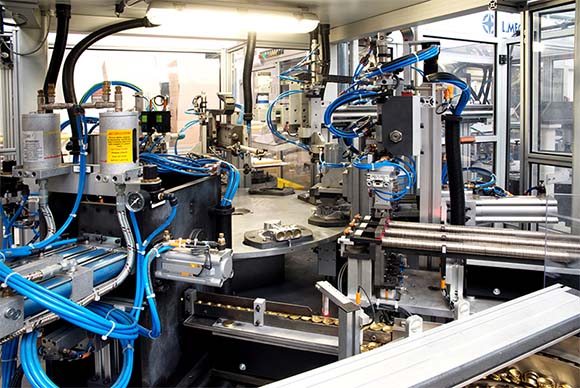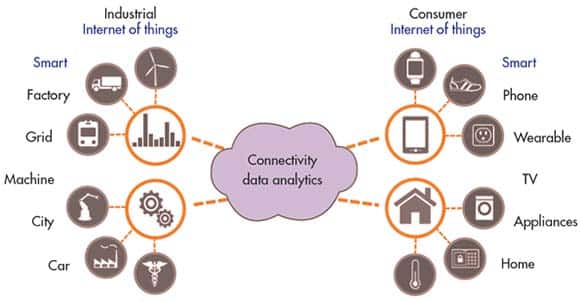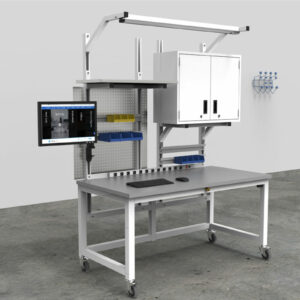Are we on the verge of another industrial revolution in manufacturing? Signs of increased cooperation — and competition — between consumer technology companies and traditional industrial manufacturers indicate the answer is yes.
Is the Dawn of the Fourth Industrial Revolution at Hand?
You say you want a revolution?
Many economists and technology consultants feel we are on the cusp of a new, fourth industrial revolution.
We’ve had three industrial revolutions since the 1800s:
- First Industrial Revolution: Early mechanization powered by water and steam.
- Second Industrial Revolution: Assembly-line mass production powered by electricity.
- Third Industrial Revolution: Computer-aided design (CAD) and automation powered by digital technology
So what would ‘power’ a Fourth Industrial Revolution?
The Boston Consulting Group has identified nine key technologies that it calls the building blocks of our fourth industrial revolution:
- Autonomous Robots
- Simulation
- Horizontal and Vertical System Integration
- The Industrial Internet of Things
- Cyber Security
- The Cloud
- Additive Manufacturing
- Augmented Reality
- Big Data and Analytics
How would we describe a Fourth Industrial Revolution? Looking into the crystal ball, we can see many possibilities. Product technology platforms first developed in the consumer space will enter more and more industrial markets, changing the way manufacturers interact with customers and products in the field. Artificial intelligence and robotics will extend our abilities to research and develop new products and technology. And immersive virtual reality will allow us to visualize information and new ideas as never before.
Let’s take a look at each of these building blocks one-by-one:
Autonomous Robots
What is it?
Robots that can access vast amounts of data and analytics to make well-informed decisions quickly.
https://www.youtube.com/watch?v=bxzGCNaOEEI
Amazon Warehouse Robots
Examples include:
- Factory robots that work side-by-side with human workers or replace them on the factory floor.
- Google’s experimental, autonomous driving cars.
Simulation
What is it?
Use of computer software programs that allow the creation of virtual models to examine complex systems under different conditions.
Examples include:
- Computer simulation of prototype aircraft or rocket’s performance in flight before building a physical prototype.
- Computer simulation of traffic flows on congested roads and freeways during different conditions.
- Computer simulation of factory production, such as worker and material movements during assembly operations.
Horizontal and Vertical System Integration
What is it?
Horizontal System integration refers to increasing the number of product lines or service offerings in the marketplace. Vertical System Integration refers to taking on increasing amounts of a product manufacturing process.
Examples include:
Amazon acquiring a fleet of aircrafts to deliver customer orders is an example of Vertical System Integration.
Google providing a suite of online services ranging from word-processing to shopping is an example of Horizontal System Integration.
The Industrial Internet of Things
What is it?
Sensors attached to industrial components that can transmit information over the Internet to a database for analysis of field performance, customer usage data / behavior, and more.
Examples include:
- GE and Rolls-Royce jet engines which provide real-time performance data of engine components to the pilot, airline maintenance crew, and manufacturer during flight.
- Remote sensing of electronic components in hard to reach locations, such as electronics equipment installed in tall cell phone towers.
- GE locomotives equipped with more than 200 onboard sensors, which can help trains run more efficiently.
Cyber Security
What is it?
Security measures are taken to provide legitimate users secure access to critical information while preventing Internet hackers from compromising computers in order to access or steal that sensitive information.
Examples include:
- Online security software/hardware
- Auditing tools
- Security consultants
- Law enforcement agencies
The Cloud
What is it?
A trusted third-party service provides secure Internet access to computer hardware, including online software applications and data storage.
Examples include:
- Rackspace and Amazon-hosted cloud services
Additive Manufacturing
What is it?
Commonly called 3D printing, additive manufacturing allows for the production of complex, freeform shapes by depositing individual layers of material sequentially to create an object.
Examples include:
- Divergent 3D’s Blade electric sports car built entirely from 3D printed components.
- SpaceX rocket exhaust nozzles, printed out of high-temperature resistant Inconel metal.
Augmented Reality

What is it?
Also referred to as Cyberspace or Virtual Reality (VR), augmented reality is a man-machine interface that allows us to experience spatial simulations, for productive design use as well as for entertainment.
Examples include:
- Head up displays used in aircraft and high-end automobiles.
- Games that allow users to mix virtual imagery with live imagery, such as the Pokémon game.
- Dedicated simulators, ranging from aircraft flight simulators to high-end consumer virtual reality head gear like Oculus Rift.
Big Data and Analytics
What is it?
Access to vast amounts of data and data analytics used to make well-informed decisions quickly.
Examples include:
- IBM’s Watson computer which makes use of big data to make decisions, such as healthcare recommendations for cancer treatment.
- Hadoop open-source software that supports processing and storage of extremely large datasets for downstream analysis.
- Apple’s Siri and Amazon’s Echo, which utilize artificial intelligence and machine learning to interpret and respond to natural language inputs.
Traditional Manufacturing Regions Face Challenges in Adopting New Technologies
A critical question is “How will we get there?” – followed by “Who will get there first?”
Two well-known regions of manufacturing excellence — Germany and Michigan — both strongholds in traditional automotive manufacturing — are now trying to catch up with these revolutionary changes in manufacturing.
In Germany, Angela Merkel’s government has been very active in promoting industrial policy mandates to prepare the German economy for the future. In 2010, they launched the EnergieWende (Energy Transformation) initiative to convert their entire German economy to low-carbon, renewable energy sources. The next year, the German government began promoting their second major industrial policy initiative, Industrie 4.0 (Industry 4.0), designed to help the German industrial economy dive headfirst into the coming revolution in digital manufacturing.

Meanwhile, in Michigan, there are also major efforts underway to encourage the industry to seize the moment. Private/public partnerships lead by organizations like Automation Alley are seeking to bring industry leaders in technology together with industrial manufacturing companies, both large and small.
According to Automation Alley’s Tom Kelly, in the future nearly every manufactured component will have Internet of Things (IoT) sensors built-in — which means that more and more traditional manufacturing suppliers will become, in effect, tech companies.
Kelly believes that while large industrial companies will have the financial resources to develop technology in-house or acquire start-up companies to bolster their technology portfolio, small to medium size companies will find it harder to muster the resources to make the transition.
Corporate Video from Lockheed Martin is highlighting advances in 3D Printing in Aerospace applications.
How can Manufacturers Prepare for the Challenges of Industry 4.0?
If you are a traditional manufacturing company, how can you position your company to take advantage of the coming changes?
According to Edward Latson, the Executive Director of the Austin Regional Manufacturers Association (ARMA), the move toward increased digitization of manufacturing processes placed increased pressure on employers to find skilled labor. Latson recommends extending recruiting efforts to include the development of dedicated training programs designed to attract prospective employee talent.
Here are some additional points you might want to consider when pursuing Industry 4.0 initiatives in your manufacturing organization:
- Fortune favors the bold: embrace new technologies
- Be willing to make major investments in new technology, even if it destroys old ways of doing things.
- Start to think of yourself as a technology company.
- Develop a plan to attract, develop talent in data management, software development, product integration, security, and cloud technology.
- Help change the perception of careers in manufacturing.
- Look for partnerships to acquire technology / expertise and to share development costs.
- Software gurus are often non-traditional hires; be open to self-taught individuals with unconventional work methods and hours.
- Participate in industry technology standards organizations.
- Pick technology platform partners carefully.
- Don’t assume outsourcing technology overseas is a panacea.
- Embrace collaborative work styles.
- Coopetition (a combination of cooperation and competition) may be more common as you move into the technology world.
- Collaborate with universities and startup incubators to develop expertise, hang out in makerspaces to find talent.
- Consider developing/sponsoring apprenticeship programs around makerspaces and startup incubators.
Corporate video from GE illustrates the wide range of new manufacturing processes employed in Industry 4.0 initiatives.
Planning Your Career in an Industry 4.0 World
Manufacturing companies can’t be successful without a talented workforce.
So, if you are looking for a rewarding career in modern Industry 4.0 manufacturing, what can you do now to help prepare for long-term success?
Here are some tips to consider:
- More and more candidates will need certifications in specific technologies, a practice already common in IT industries.
- Be open to change.
- As manufacturing jobs return to the US (known as in-shoring) they will likely be more automated and computer-oriented than ever before.
- If you are not sure, get an outside assessment of your skills, your potential, and the job market. Don’t rely just on the advice of trainers who are paid to train a new skill.
- If learning new manufacturing technology skills is not a fit for you, consider finding work in high-end artisanal workshops that use traditional skills and methods, or find work in the construction field which (for now) has less automation.
- Be open to relocation.
Let Formaspace be Your Competitive Advantage in Manufacturing
Are you planning for the future of manufacturing?
Formaspace can help.
Our flexible furniture solutions for manufacturing, shipping, and receiving are in use worldwide at leading tech companies like Amazon, Apple, and Dell Computer as well as at major manufacturing companies and suppliers such as 3M, Boeing, Ford Motor Company, Keuhne+Nagel, Lockheed Martin, McMaster-Carr Supply Company, Toyota and more.
Get in contact with your friendly Formaspace Design Consultant today. We’re ready to share our many years of experience in creating innovative, productive manufacturing workspaces with you.












